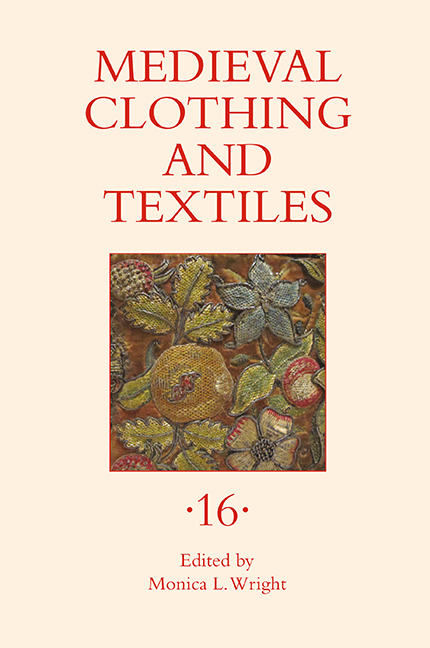Book contents
- Frontmatter
- Contents
- Illustrations
- Tables
- Contributors
- Preface
- 1 Anglo-Saxon Banners and Beowulf
- 2 The Use of Curved Templates in the Drawing of the Bayeux Tapestry
- 3 Construction and Reconstruction of the Past: The Medieval Nordic Textile Heritage of Hemp
- 4 Historicizing the Allegorical Eye: Reading Lady Mede
- 5 Sex, Lies, and Verdugados: Juana of Portugal and the Invention of Hoopskirts
- 6 Fashion and Material Culture in the Tabletop of the Seven Deadly Sins Attributed to Hieronymus Bosch
- 7 The Broderers’ Crown: The Examination and Reconstruction of a Sixteenth-Century City of London Livery Company Election Garland
- Appendix 7.1 Surviving Sixteenth-and Seventeenth-Century Embroidered Crowns of the City of London Livery Companies
- Recent Books of Interest
- Author Index, Volumes 1–15
5 - Sex, Lies, and Verdugados: Juana of Portugal and the Invention of Hoopskirts
Published online by Cambridge University Press: 27 March 2021
- Frontmatter
- Contents
- Illustrations
- Tables
- Contributors
- Preface
- 1 Anglo-Saxon Banners and Beowulf
- 2 The Use of Curved Templates in the Drawing of the Bayeux Tapestry
- 3 Construction and Reconstruction of the Past: The Medieval Nordic Textile Heritage of Hemp
- 4 Historicizing the Allegorical Eye: Reading Lady Mede
- 5 Sex, Lies, and Verdugados: Juana of Portugal and the Invention of Hoopskirts
- 6 Fashion and Material Culture in the Tabletop of the Seven Deadly Sins Attributed to Hieronymus Bosch
- 7 The Broderers’ Crown: The Examination and Reconstruction of a Sixteenth-Century City of London Livery Company Election Garland
- Appendix 7.1 Surviving Sixteenth-and Seventeenth-Century Embroidered Crowns of the City of London Livery Companies
- Recent Books of Interest
- Author Index, Volumes 1–15
Summary
Every reader of this journal knows hoopskirts, in their many styles, as iconic aristocratic fashions of late medieval and early modern Europe, depicted in numerous paintings from those eras. Many may also have read the story that Juana of Portugal, second wife of King Enrique IV of Castile, invented the garment to hide illicit pregnancies. Like any new fashion in the later Middle Ages, hoopskirts attracted criticism, especially from clerical moralists, who decried their extravagance, cost, peculiar appearance, incentives to lust, unhealthy side effects, and cumbersome use. Whether any women actually used hoopskirts to conceal pregnancy may remain forever impossible to know. However, the political opponents of Enrique IV did not hesitate to appropriate this claim as one of many slanderous accusations made against his queen, during the decades when they fought to replace him on the Castilian throne with his siblings Alfonso and Isabel.
This study reviews the earliest known textual and artistic evidence regarding the appearance of hoopskirts at the Castilian court in the mid-to late fifteenth century, including its enthusiastic adoption by Isabel as queen of Castile. It contrasts evidence of the new fashion's popularity with the often-cited denigration of hoopskirts by Isabel's official chronicler Alfonso de Palencia and by her confessor Hernando de Talavera. Their vilification of the new fashion became a commonplace in attacks on hoopskirts into the early modern era. This study concludes that the association of Juana of Portugal with immoral use of verdugados, disseminated during a period of intense partisan strife, was a fiction of political propaganda. Nonetheless, that fiction was so potent that it cemented the legend of the hoopskirt's ignoble invention as a topos for disparaging the fashion into modern times.
As Carmen Bernis Madrazo explains in her comprehensive survey of Spanish fashions from this era, the original Spanish term for the new fashion was verdugo (green branch), because freshly cut wicker branches or canes were used to create hooped skirts. Attached in concentric horizontal rings around a skirt, the bent canes created a billowing cone or bell shape. A skirt enlarged in this way was termed verdugado (caned). From this Spanish adjective was derived, with some phonological deformation, the English noun farthingale.
- Type
- Chapter
- Information
- Medieval Clothing and Textiles 16 , pp. 101 - 122Publisher: Boydell & BrewerPrint publication year: 2020

